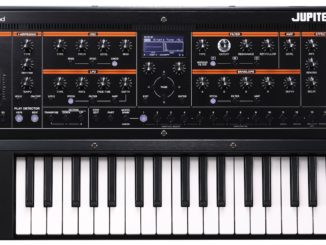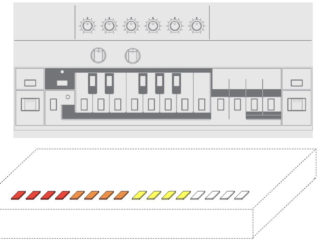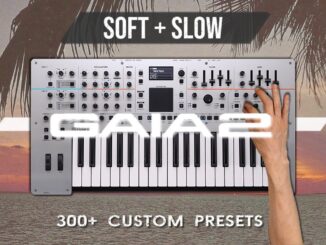Roland GAIA 2 follows the best-selling GAIA polysynth and continues the hands-on concept with new hybrid with wavetable and virtual analog synthesis.
Typically, synthesizers stay on the market for a few years, then are replaced or disappear completely. There are exceptions. See the Korg microKorg, which has been on sale since 2002. Until recently, the Roland counterpart was the GAIA, a digital virtual analog poly synth from 2010. This was recently discontinued.
There is a reason for this step. With the GAIA 2, Roland shows the successor based on their ZEN Core Engine a newly developed hybrid engine.
Roland GAIA 2
Compared to the original, the GAIA 2 is a big step forward in terms of sound and features. The new generation is powered by a newly developed hybrid engine and not 100% ZEN-Core. For the new GAIA 2, Roland has chosen a 1-oscillator version of its recently introduced n/zyme wavetable engine, virtual analog synthesis with bits and bytes from ZenCore and model expansions. So almost a best-of of the current Roland synthesis techniques.
It has a maximum of 22 voices and three oscillators per voice. Each oscillator has its distinct characteristics.
Wavetable Meets Virtual Analog Synthesis
In oscillator 1, you can find the wavetable block with 63 morphing waveforms. It has various parameters, including wave position, phase modulation (P-MOD), and shaping mod (S-MOD).
Both oscillators 2 and 3 use GAIA 1-style virtual analog synthesis with classic waveforms: sine, triangle, saw, square, super saw, and five noise waves. Plus, you can bend the waves with shape, ring mod, oscillator sync, and two cross mods. Unison is also available.
If that’s not enough, the new GAIA also supports Model Expansions and ships with the SH-101 ME, a polyphonic recreation of a monophonic legend. Alternatively, you can purchase/loan other models via Roland Cloud, such as the Jupiter-8, JX-8P, or the Juno-106.
Then, these three oscillator blocks flow into a multimode filter with -12dB/Oct, –18dB/Oct, -and 24dB/Oct lowpass, bandpass, and high pass types. There is also a filter drive.
To finalize your sounds, the hybrid engine powered GAIA 2 has a multi-FX section with 53 different FX types, including a new shimmer reverb, delays, chorus, and more. Plus, there is a master EQ and compressor.
Modulation & Sequencing
On the modulation side, you get three envelopes, two ADSR (filter, amp), and an AD envelope. The latter is the most flexible because it can be routed to parameters like pitch, OSC 1 position, OSC shape, and more. Next to this, GAIA 2 also has two multi-wave LFOs with five waveforms and a programmable step LFO wave. The LFOs can be assigned right on the front panel with knobs and sliders.
A built-in sequencer with 64 steps, 8-voice polyphony, and parameter automation (4 controls per step) gives you a powerful tool for creating sequences. It hosts various recording modes (real-time, step/ TR-rec), probability, and a random pattern generator. Besides this, it also includes an arpeggiator with different modes and a scale function with 16 variations.
Hands-On Control
The new GAIA 2 has even more hands-on control than the first generation. You have more knobs and sliders that you can tweak right on the panel. I like that a lot.
Another highlight is an all-new motion pad in the middle of the user interface that says goodbye to the D-Beam. You can either two-dimensional control the P-Mod/S-Mod depth + drive or assign any knob or slider from the interface to it. These XY motions can also be captured and playback. This allows you to generate very complex, organic sounds that are in constant motion.
The new GAIA 2 has a 37-key keyboard with velocity and aftertouch, and pitch bend + mod wheels on the side. You can also work with portamento and with a chord memory function. It ships with 256 presets and you can save your own sounds in 512 user slots.
Connectivity
A look at the back should not be missed. Here you can find a 5-pin MIDI interface (in/out), an expression pedal input, stereo output (L/R) on 6.3mm sockets, a phones socket, and extensive USB connectivity, including USB device and computer ports.
Like the other new Roland synths, the GAIA 2 also functions as an audio/MIDI interface using the USB-C port. This means you can transfer the audio digitally via USB to your computer, tablet, or phone, with no driver installation needed.
The USB Type-A (device) port is also available for connecting a USB flash drive for data backup or a standard USB MIDI controller for extended operation. GAIA 2 also supports Roland Cloud Connect with the optional wireless adapter. Lastly, there is also an optional CB-B37 keyboard bag available giving you high-quality protection for synths like the GAIA 2 or JUPITER-XM.
First Impression
On the feature paper, I really like the new GAIA 2. Roland does a lot of things right here that they did wrong with their JUPITER-XM. Especially the user interface that makes the new engine much more immediate and accessible.
The engine is nothing breathtaking new. It’s a classic engine with some tweaks. However, I think it’s great that we now get a standalone synth with some bits of the n/zyme supported by classic VA synthesis. A solid successor that I think makes you forget the original GAIA. Ok almost, there is no D-Beam in the new generation.
Roland GAIA 2 is available now for $899,99 / 869€.
More information here: Roland
Available at my partners







Will there be a desktop version this time? I’m a big fan of the Roland MX-1 with its bi-directional USB ports (AIRA Modular Customizer 🙂 ). The GAIA 2 probably also connects to the MX-1 via USB, but the keyboard version is still too big for my setup. The System-8 also never was an option, simply because of its size.
Where did you see a mention of after touch for the keybed ?
sorry Roland didn’t communicate about it so I expected it has aftertouch, but I just get the confirmationen that there is no aftertouch
Yawn
“At first, the Gaia 2 seems to be ticking all the boxes!”
Oh nice, a new Korg Monologue! Oh wait…
But is it Zen core? Zen core is nowhere mentioned on the roland site.
Seems more like done on the sh-4d, a specific digital engine.
I like it. It seems not just another controller for zencore but its own concept.
Also: guess we do not get a sh-4d with keys then becasue there is the gaia2 now.
The core architecture is ZEN-Core. Also the SH-4d is ZEN-Core in the core but simplified. For the GAIA 2: the wavetable part is from the n/zyme model expansion while the virtual analog part is from the main ZEN-Core engine.
If you look at the controls, it’s like a successor to the System-8 in an alternative universe.
Oh, how I would have loved to see a System-22 instead. Imagine ACB, not Zen-Core, 5 octave keyboard with aftertouch, 6 to 8 plug-ins, and then same add-ons from Gaia-2; second LFO, wavetable in the oscillator, graphical display.
Had a Gaia. The hands on control made it really easy to program. I’m happy to see they’ve kept it that way. I love that Roland always has audio via USB. That really should be standard imo for any synth, and is why I support Roland most of the time even if they do have atrocious menu diving. I’ll give this one a go someday but I’m pretty happy with my fantom for now. It’s pretty pricey at 900 tbh.
Yes! I’ve seriously asked for the Gaia 2 since I picked up a Gaia in 2015(?) and sold it a year or two later. But the beauty of Gaia was its multi-timbral nature. You could control 3 independent voices at once or set them up individually. This allowed for some crazy performance pads with essentially 3 different synth sounds. Don’t see that here…. But I’m game! Gaia didn’t sound great but it had lots of options (some meaningful, some not) and the FX was fun to quickly add in. Really was not expecting this.
Looks very cool
Listened to some of the demos, if they’ve been recorded badly it shows, if not, then Roland have got some fixing to do.
However they’ve implemented the audio engine or internal mixing, it’s lifeless and utterly lacking in dynamic range.
It sounds dull.
Plus, a seeming lack of focus means the sounds all have a “general midi” lounge bar quality to them.
Great for light jazz, useless for anything else.
Is this what Roland meant to do?